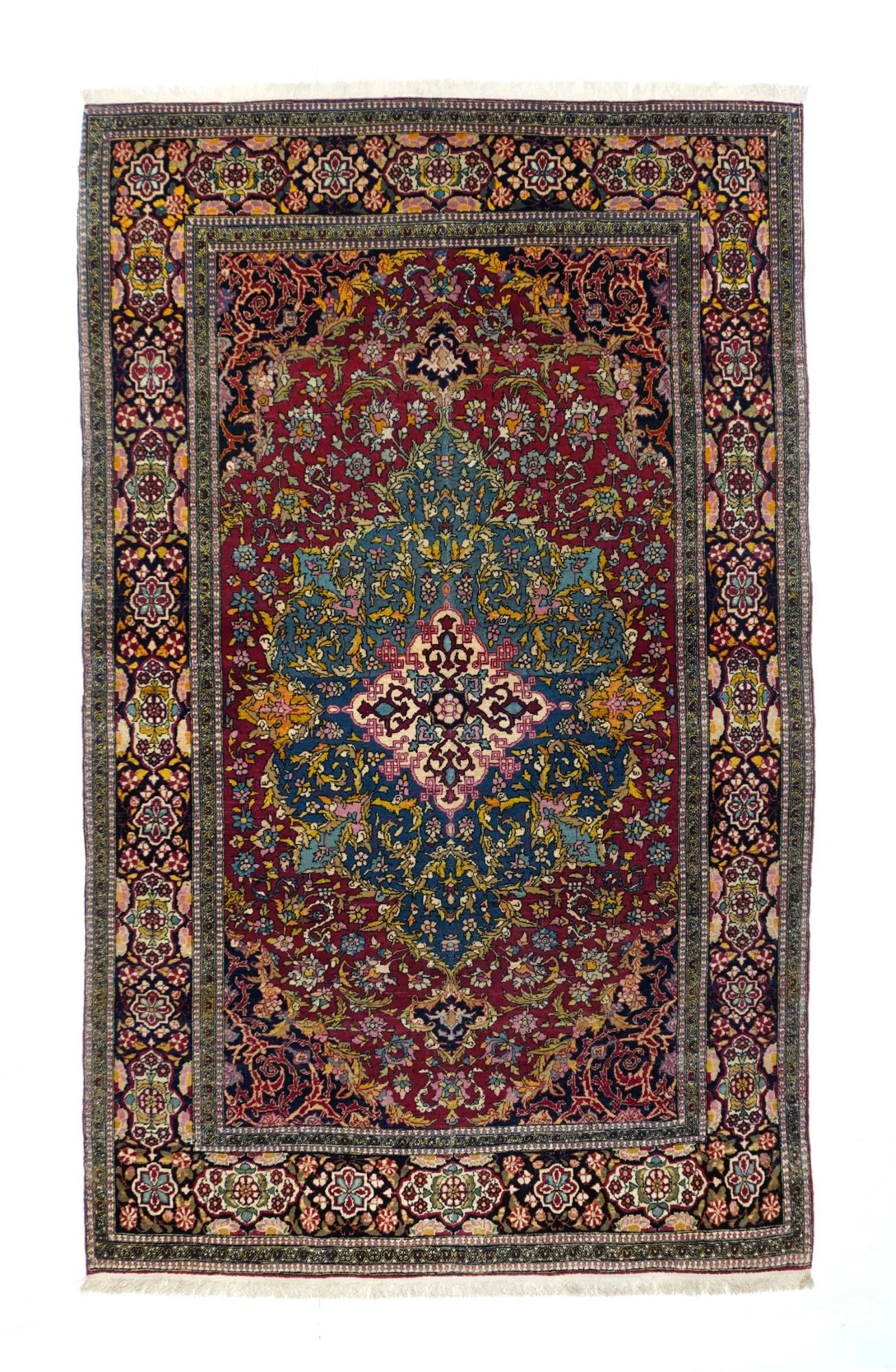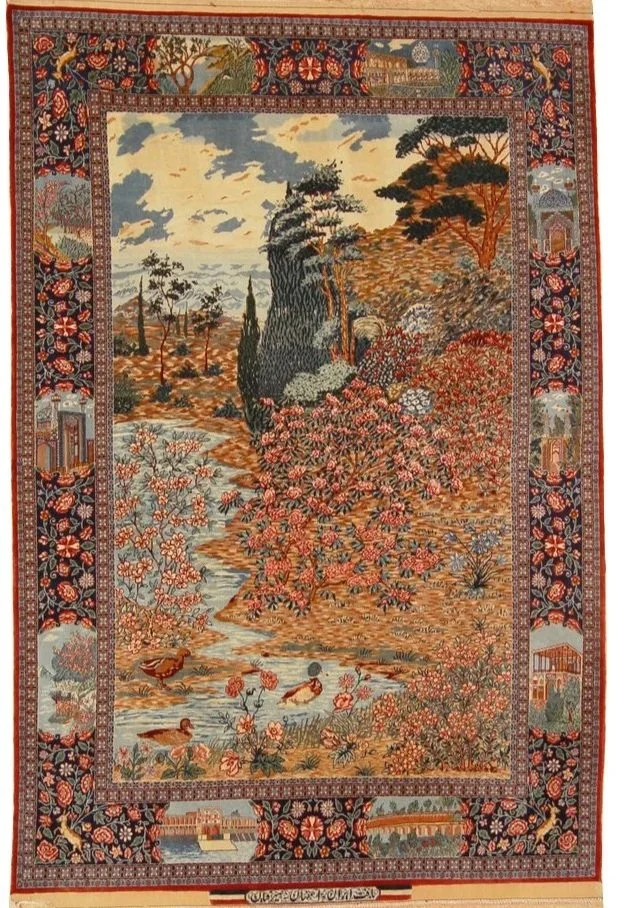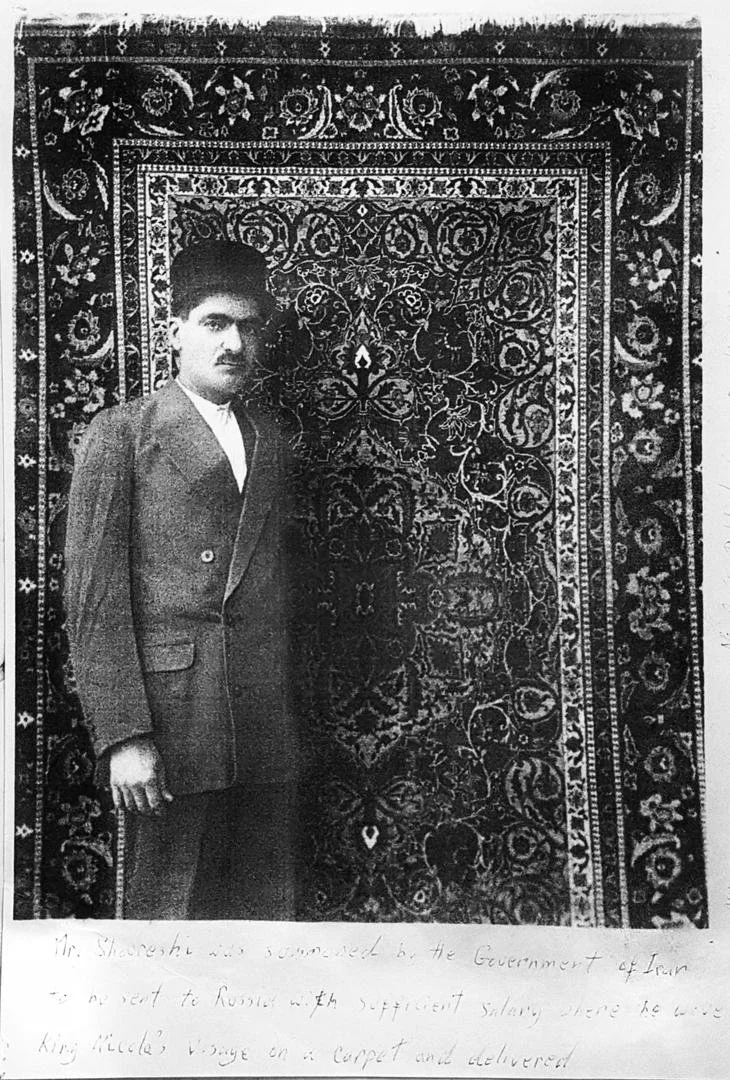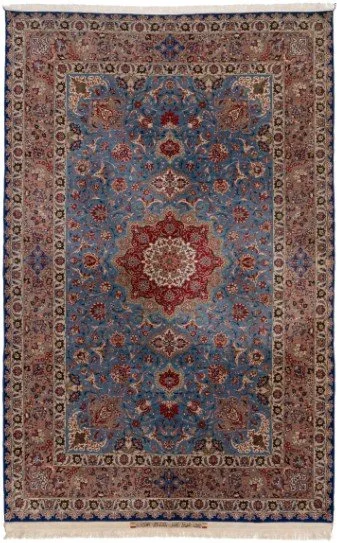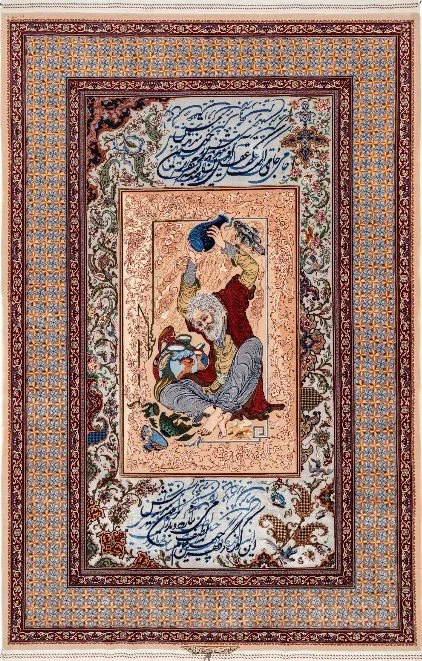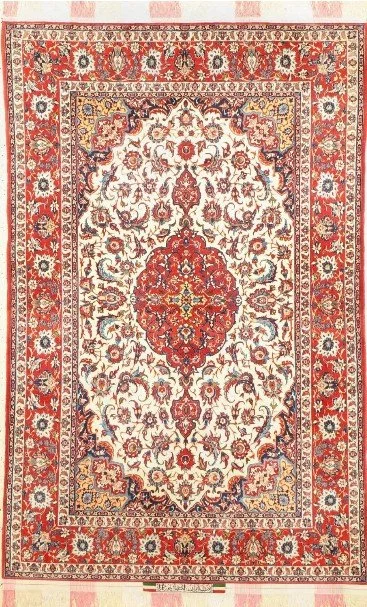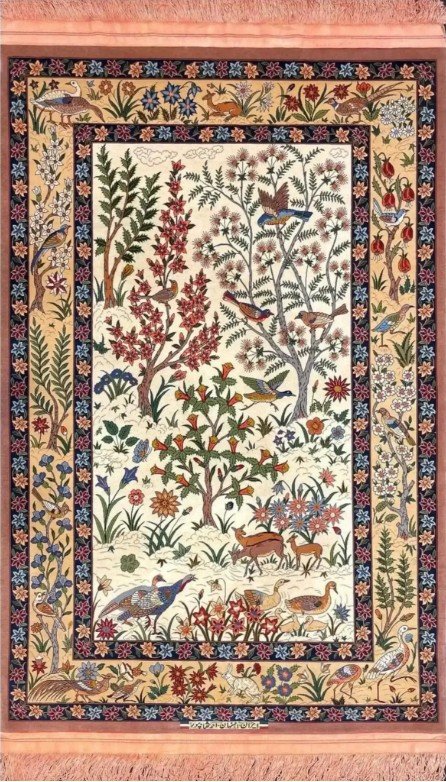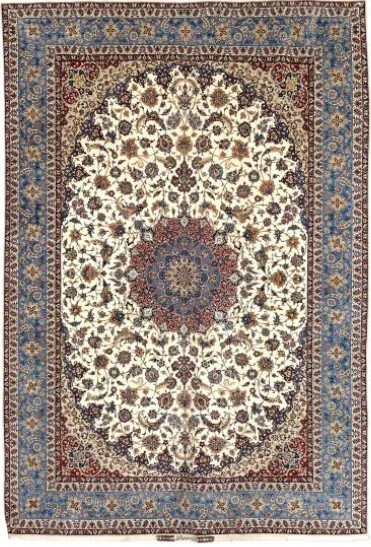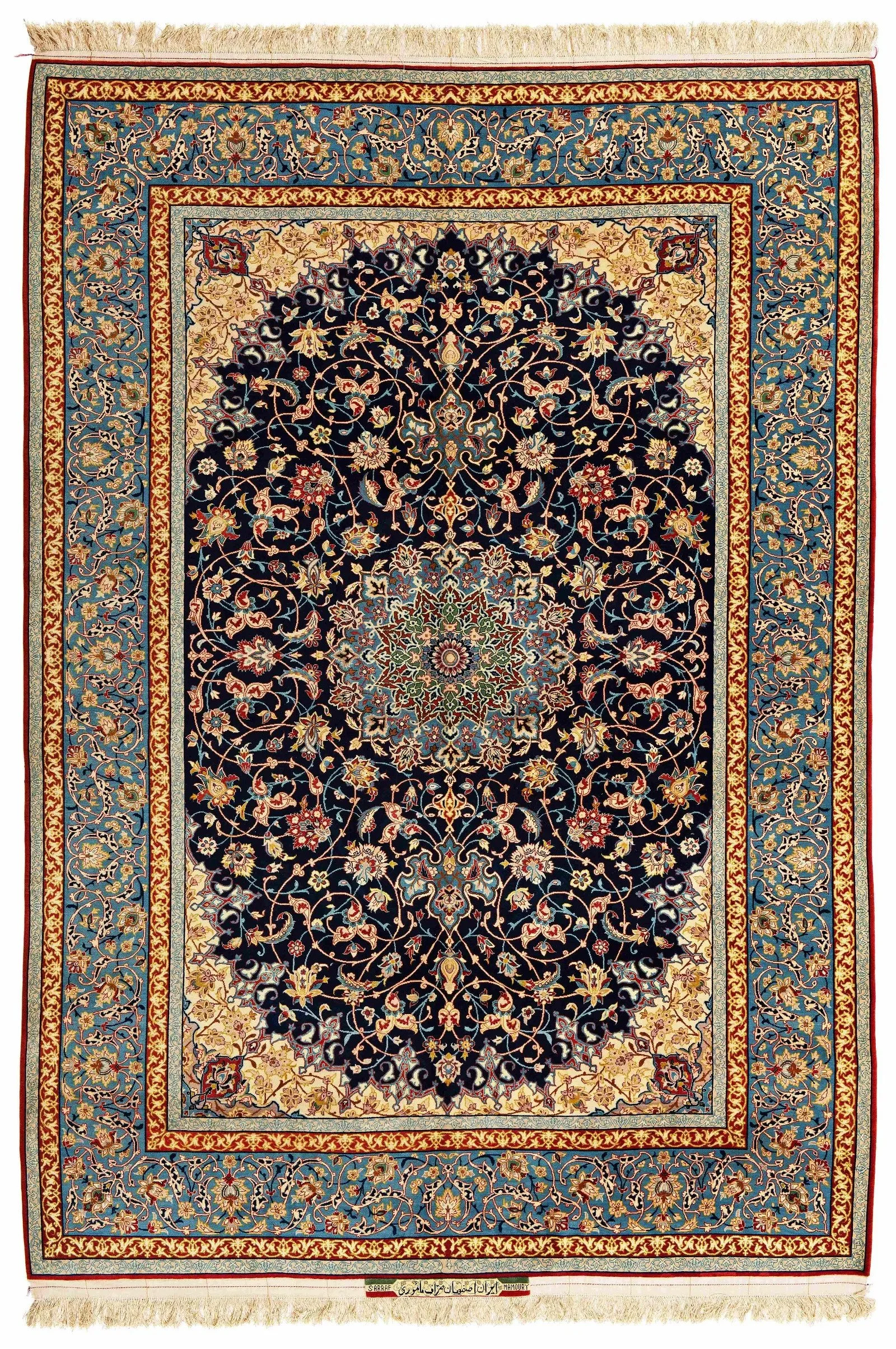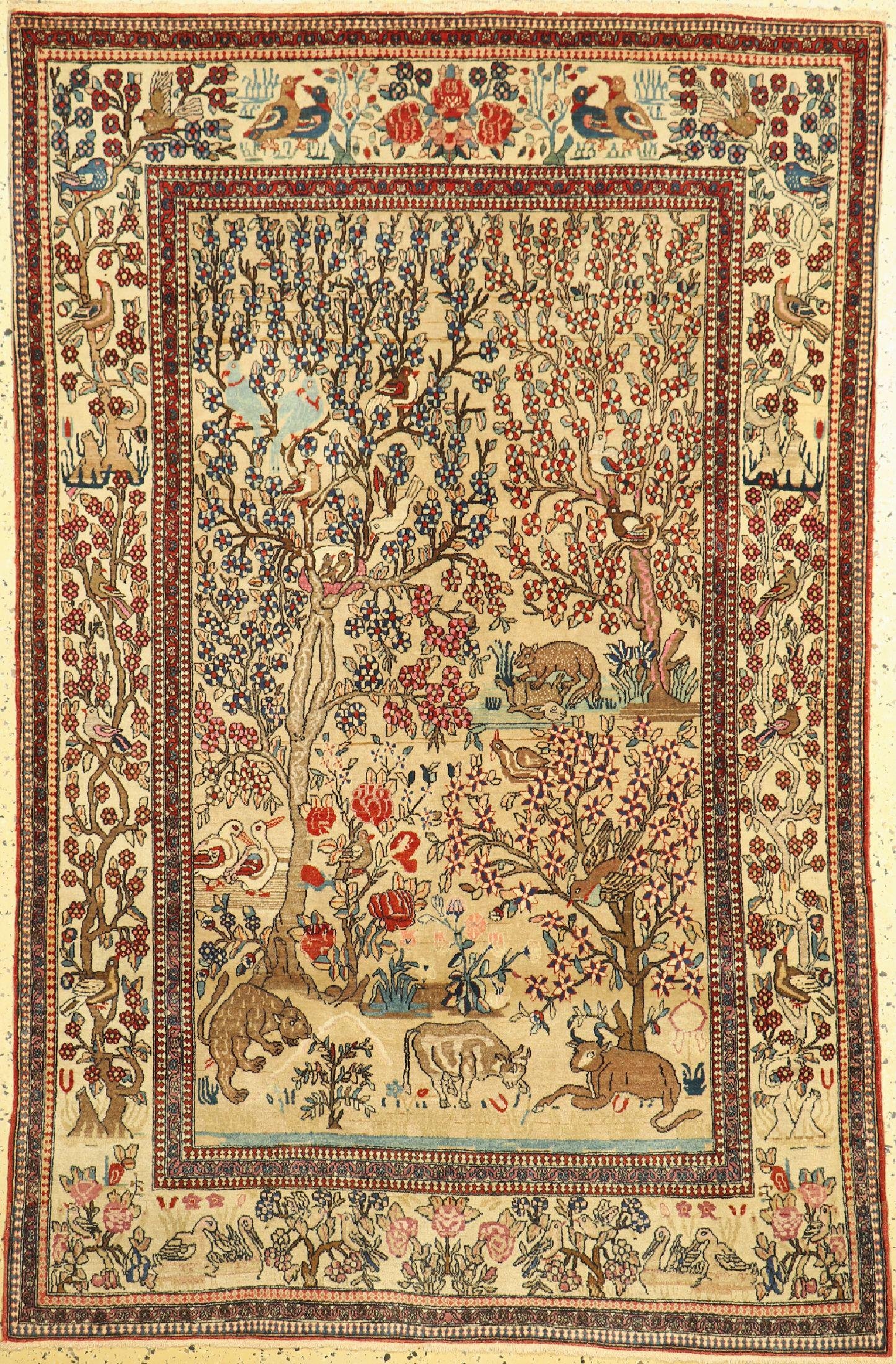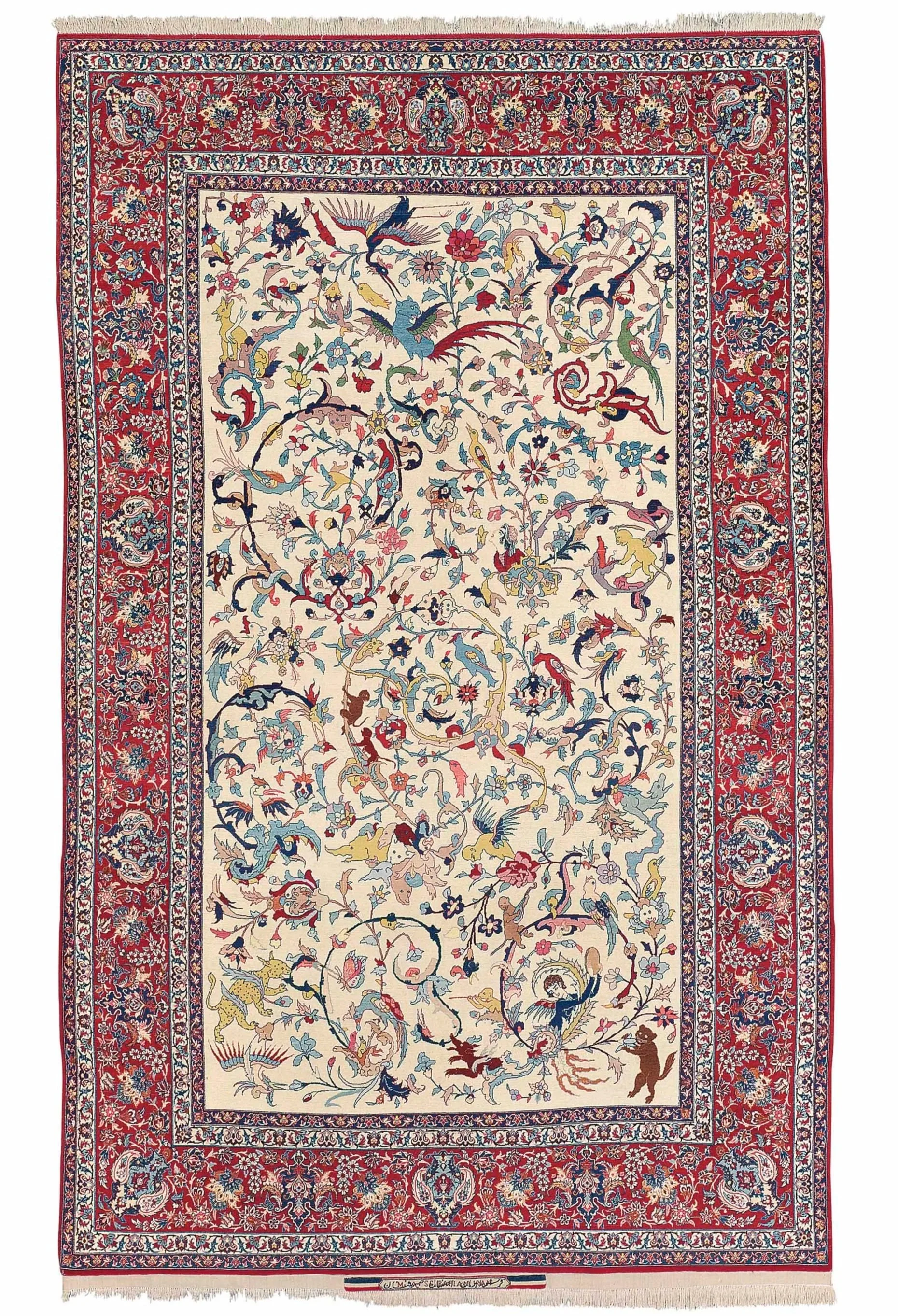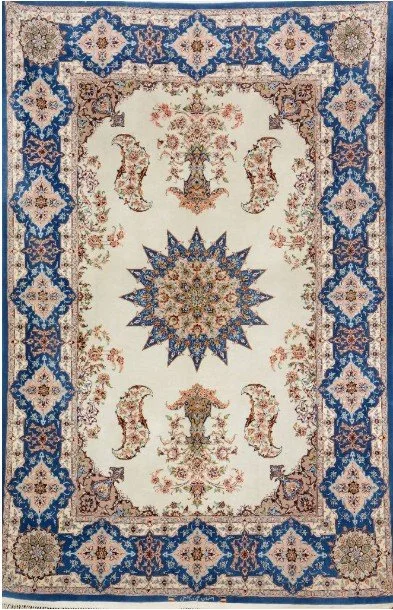ISFAHAN
Origins: Isfahan Persian rugs originate from the city of Isfahan in central Iran (formerly Persia). Isfahan has a rich history of rug weaving dating back centuries, and its rugs are esteemed for their exceptional craftsmanship and intricate designs.
Design: Isfahan Persian rugs are characterized by intricate floral motifs, arabesques, medallions, and curvilinear patterns. These designs are meticulously executed with fine detail and precision, often incorporating rich colors such as deep blues, crimson reds, ivory, gold, and soft greens.
Construction: Isfahan rugs are handcrafted using high-quality materials such as fine wool, silk, and cotton. Silk is often used to highlight intricate details and add luster to the rug's surface. The rugs are hand-knotted using the Persian knot technique, resulting in a dense and durable pile.
Size and Shape: Isfahan Persian rugs come in various sizes, ranging from small accent rugs to large room-sized carpets. They are available in rectangular, square, and even round shapes, catering to different design preferences and spatial requirements.
Quality and Collectability: Isfahan Persian rugs are among the finest Persian rugs, prized for their exceptional quality, intricate designs, and historical significance. They are highly sought after by collectors and connoisseurs around the world and are considered valuable investments due to their craftsmanship and enduring popularity.
Cultural Significance: Isfahan Persian rugs are part of Iran's rich cultural heritage and represent a tradition of artistry and craftsmanship that has been passed down through generations. They serve as symbols of Persian culture and artistic ingenuity, reflecting the region's history, literature, and aesthetics.
Evolution: Over time, Isfahan Persian rugs have evolved to incorporate a blend of traditional designs and modern elements to appeal to contemporary tastes. While traditional motifs remain popular, modern Isfahan rugs may feature innovative color palettes or reinterpretations of classic patterns.
Antique Isfahan carpet that is best of type
History
Isfahan, the capital of the Persian empire during the Safavid rule was the most prominent weaving center. The Safavid rulers were great patrons of the arts, and they fostered an environment conducive to artistic expression. Shah Tahmasp I (1524–1576) and Shah Abbas I (1588–1629) were particularly renowned for their support of the arts, including rug weaving. There is less than 1500 examples of such carpets that are known to exist, Many have been acquired by famous musuems around the world.
The baron adolphe carl von rothschild ‘polonaise” carpet property of a german nobleman sold at christies
Together with a subtle palette of powder blue, indigo, sage-green, peach, and pale yellow the present carpet is woven with a heavily brocaded gold and silver field and a silver brocaded border. The hallmark shimmering silver and gold tones of ‘Polonaise’ carpets were achieved by wrapping extremely fine silver-gilt and silver thread diagonally around silk threads.
The Pommersfelden ‘polonaise’ carpet sold at chrisities
Second Revival- like it has never been told before
During the late 19th Century and early 20th century, a drastic revival in carpets occurred. The Persian nation prepared to produce their best-in-class carpets, and Isfahan was at the center of this transformation.
Mirza AGHA EMAMI
Out of all the famous names in the world of art in Isfahan, Mirza Agha Emami takes the crown of the modern age. Emami’s artistic genius does not receive enough credit, with many of his students such as Ahmed Archang regarded as the pinnacle of designers of the modern age. One must stop at the remarkable designs of his works such as the carpet to the left, this level of detail has yet to be rivaled in today’s work
A beautiful antique isfahan commissioned by abdul mutalib
Abdul Rahim Shureshi - The most prominent of abdul mutalib son’s
Born in 1869 Abdul Rahim Shureshi is celebrated as the great reviver of rug weaving in Isfahan. Born in 1869, his prodigious talent was recognized at a young age by the Shah of Iran, who admired the exceptional quality of his carpets. To this day, antique Isfahan rugs of the highest caliber are often referred to as “Shureshi” pieces, whether or not they were woven by him, a testament to the uncompromising standards he set for precision, beauty, and craftsmanship.
His only son, Abbas Shureshi, inherited both his father’s skill and his vision. Abbas became renowned for his mastery of traditional dyeing techniques and for his close collaboration with the legendary Haj Agha Reza Seirafian. Through Abbas, the Shureshi name remained synonymous with excellence.
Abdul Rahim’s brothers—Abdulkarim, Abdulkhalegh, Abdulrazagh, and Abdulghaffar—initially worked under his direction, though the second and fourth later established their own rug enterprises.
The Shureshi legacy continues into the modern era. Abbas was the father of Vahid and Hamid Shureshi, who have carried the family tradition forward, ensuring that the name “Shureshi” remains a mark of artistry, discipline, and heritage in the world of Persian carpets.
A Gorgeous isfahan carpet drawn by emami and woven in the shureshi workshop
hAJ aGHA REZA Seirafian
Haj Agha Reza seirafian began his career in rug weaving in 1939. Originally a banker , decided to produce a best of type carpet. he employed the most talented designers, skillful weavers and procured the best natural dyes and wool and silk of his time. Starting his career at a later age, his production was limited, making his carpets highly desirable among seasons collectors. Haji was survived by 7 sons who also work in carpet production. The most prominent of which is haji Mohammad seirafian
A beautiful 1930’s isfahan carpet attributed to artist mirza agha emami the workshop is probably mehdi haghighi
Haj agha reza seirafian with his 7 sons
aHMED ARCHANG
The islimi legend of isfahan, Ahmed archang was a student of Haj Mirza Agha Emami, A revered artist Archange mastered the art of drawing eslimi’s (curvilinear drawing of carpets) he was commissioned heavily by several workshops to design Persian rugs, the most prominent of all is the seirafian workshop
Designed by archang and produced by haj agha Reza seirafian
hAJ MoHammad seirafian
Grand Master Mohammad Seirafian is the co-founder of the Seirafian Carpet dynasty with his father Haj Reza Seirafian. Haji is hands down the greatest producer of Persian carpets in the twentieth century. A philanthropist and a humanitarian at heart. In a tremendous act of generosity and without any support from anyone, he donated his greatest-ever masterpiece to the United Nations to bring the message of peace and unity to the rest of the world. This incredible masterpiece contains more than 1350 knots per square inch and was a decade in the making
it is our opinion that the true genius of Grand Master Seirafian has not fully gotten the attention it deserves he will most definitely go down in history as one of the greatest and most influential Persians of our time. Haji cared truly about his people and at times bought them houses to live in. His vision of peace and harmony between all mankind has yet to be fully understood. His masterpiece is displayed in the UN Headquarters in New York, a picture of this remarkable rug can be seen to your left.
For more information visit: www.un.org/ungifts/persian-carpet
A masterpiece by haj mohammad seirafian donated to the UN
hAJ sadiq seirafian
The Late Master Sadegh Seirafian (1922- 2005), one of the sons of Haj Agha Reza Seirafian became a carpet master producer after graduating from high school. He was also talented as a designer often creatively helping designers develop their sketches. Sadegh used his unique inscription, which added his full name in English to the inscription of the Serafian workshop. Having considerable interest and the same dreams as his father, he combined the dexterity of the skillful masters with his innovative thoughts and began to produce carpets. His works have attracted hundreds of enthusiasts, artists, and highly reputable collectors of high-quality hand-woven rugs and carpets. He was by far the largest producer of carpets in his generation
A beautiful scenary by ahmed seirafian
Master Abdul Samad Isfahani
Master Abdolsamad was a pivotal figure in the revival of Isfahan carpet weaving during the mid to late 19th and early 20th centuries. Master Abdol samad, along with master abdul mutalib his brother are regarded as the founding fathers of modern Isfahani rug production. His workshop became known for its exceptional quality, particularly in the execution of intricate floral and medallion designs, which helped set new standards for the craft at a time when it was struggling to recover from its decline after the Safavid era.
Born in 1840, Master Abdol Samad Khan embarked on a pioneering journey in carpet weaving after he and his brother ingeniously reverse-engineered a saddlebag crafted from Persian rugs. Their innovation sparked a flourishing family craft, one that continued to thrive and evolve within both Abdol Samad Khan’s lineage and that of his brother, Abdol Mutalib Khan.
Although detailed records of his life remain scarce, Abdolsamad’s reputation rests on his mastery of both design and technical weaving. Only three carpets that are signed are known to exist today, one of which is still preserved and admired in the tehran Museum. His daughter also contributed to the family legacy by weaving carpets that embodied national pride, often referred to as “Madar Vatan” (Motherland). These works collectively represent not only artistic achievement but also a cultural revival deeply rooted in Persian tradition.
Abdolsamad’s workshop was more than a center of production; it served as a training ground for future masters. Among his notable apprentices was Haj Mehdi Safdarzadeh Haghighi, who began his career under Abdolsamad’s guidance.
abdul rahim shooreshi standing with one of his production rugs
Ahmad Shahapour (ACTIVE TODAY)
Ahmad Shahapour is a living legend among contemporary Isfahan carpet artists, known for producing exclusive limited editions. His “Shahapoor Paradise” series depicts detailed Persian gardens woven on silk foundations with knot densities exceeding 800 knots per square inch.
His use of natural dyes and masterful technique makes his carpets prized collector items.
Specialty: Limited edition carpets with silk foundations
Knot Density: 800+ knots per square inch
Signature Work: “Shahapoor Paradise” series
Materials: Silk and wool with natural dyes
Ahmed Isfahani (Early 20th Century)
Ahmed Isfahani, often identified with Agha Ahmad Ajami, was a key figure in the revival of Isfahan carpet weaving in the early 20th century. At a time when the city’s weaving traditions were recovering from decline, he founded what became known as the “Ahmad school”, producing carpets that set both technical and aesthetic benchmarks. Many antique carpets are signed “Ahmad Isfahan” or “Ahmad Ajami,” a testament to his workshop’s influence and enduring recognition in domestic and international markets.
His carpets are distinguished by tight knot density, cotton foundations, dry wool piles, and vibrant yet darker-hued dyes, creating depth and longevity in the finished pieces. Ahmed Isfahani drew inspiration from classical Persian motifs, incorporating central medallions, Shah Abbasi palmettes, Islimi arabesques, and Tree of Life compositions. These designs exemplify a seamless blend of tradition and innovation, positioning his workshop as a precursor to later masterful Isfahan weaving schools such as Seirafian.
Key Highlights:
Artistic Focus: Pre-Seirafian Isfahan carpets with classical Persian motifs
Techniques: Tight knotting, natural dyes, cotton foundation, dry wool pile
Design Innovations: Medallions, Shah Abbasi motifs, arabesques, floral and Tree of Life patterns
Legacy: Influenced subsequent Isfahan carpet schools and workshops; his carpets remain highly collectible
Recognition: Carpets appear in antique auctions and dealer catalogs worldwide
Ahmed Isfahani’s work represents the bridge between classical Persian carpet artistry and the modern Isfahan revival, making him a cornerstone of the city’s weaving heritage. Though precise biographical details are scarce, the signature style and quality of his carpets continue to attest to his lasting impact on Persian art and craftsmanship.
Mirza hashem Kord-Azad (workshop)
Stitched into the rich tapestry of Isfahan’s carpet heritage, استاد خورد آزاد (“Master Khord Azad”) emerges as one of the dedicated weavers who sustained the tradition of Shah‑Abbasi designs during its revival in the late 19th and early 20th centuries. Alongside peers such as Abdol Samad Isfahani and Mehdi Haghighi, Khord Azad contributed to a flowering of carpet art in Isfahan, supported by patrons like Zill‑os-Soltān, son of Nasser al‑Din Shah.Kord-Azad workshop maintains classical Isfahan weaving methods and natural dye usage. They produce carpets prized for design clarity and longevity.
Focus: Traditional knotting and natural dyes
Style: Classical Safavid motifs
Reputation: Valued for craftsmanship and authenticity
An amazing hekmat nejad carpet
Mohammad Ali Seirafian
Mohammad-Ali, the eldest of the brothers, began his journey in the carpet-making industry in the early 1940s and continued his work until his passing in 2011 at the age of 92. Throughout his career, he focused on traditional designs and was known for maintaining exceptional craftsmanship. His carpets consistently featured very fine knot densities—often exceeding 10 knots per centimeter—and displayed intricate, precise patterns. Because he produced fewer pieces compared to brothers like Sadegh or Mohammad Seirafian, his works are considered rare and highly valuable. To the right one can see a beautiful vaq vaq style carpet. an incredible drawing and execution
A beautiful depiction of omar al kayyam by akbar mehdai
ABDUL Mutalib ISFAHANI
AbdolMataleb Khan was a pivotal figure in the early development of Persian carpet weaving, working alongside his brother, Master AbdolSamad Khan, in the mid-19th century. While AbdolSamad pioneered the craft through innovation and experimentation, AbdolMataleb carried this legacy forward within his own family, establishing a distinct school of artistry and craftsmanship.
He had six sons, several of whom—most notably Masters Abdul Rahim Khan, Abdul Ghaffar Khan, Abdul Karim Khan, Abdul razagh khan and Abdul Khaleq Khan—became highly respected weavers in their own right. Collectively known as the “Rebel Family or Shoreeshi,” they transformed traditional Persian carpet design through bold new patterns, techniques, and artistic expression.
The AbdolMataleb family’s influence extended beyond their own generation, shaping the artistry of future masters such as Haj Mehdi Khan Safdarzadeh Haghighi. By blending innovation with deep respect for tradition, AbdolMataleb Khan and his descendants played a crucial role in elevating Persian carpet weaving into a refined and enduring art form.
DARDASHTI
The Dardashti family workshop, founded in 1921 by Haj Ali Dardashti in Isfahan, has become one of the most respected names in Persian carpet weaving. Ali Dardashti distinguished himself early by introducing silk warps into his carpets, a mark of refinement that set his pieces apart in both the Isfahan and Naien styles. Following his passing, leadership of the workshop passed to his son Abbas Dardashti, who continued to expand the reputation of the brand while preserving the high standards of craftsmanship established by his father. Today, the workshop is run by the third generation, ensuring the continuity of tradition alongside carefully considered innovation.
Dardashti carpets are renowned for their fine knot density, delicate structures, and masterful use of natural dyes, producing deep, durable, and harmonious color palettes. The designs often feature medallion and Shah Abbasi motifs, as well as Islimi arabesques and Golfarang (rose-garden) patterns—all hallmarks of the Isfahan school. Every stage of production, from design and dyeing to weaving, is overseen within the workshop itself, allowing for exceptional quality control. Many pieces carry the woven signature “Isfahan 110 Dardashti,” a mark of authenticity recognized by collectors worldwide.
Over the past century, Dardashti has built not only a commercial brand but a cultural institution within Isfahan’s artistic legacy. Their carpets are sought after for both decorative beauty and investment value, appealing to collectors in Iran and abroad. By balancing tradition with contemporary sensibilities, the Dardashti family has ensured that their workshop remains a central pillar of Persian carpet art—a living testimony to how dedication across generations can turn a family name into a global standard of excellence.
Sadegh seirafian master piece
Dr. Hassan Hekmat-Nejad Majnuni & Family
Dr. Hekmat-Nejad is renowned for producing some of the highest knot-density Persian carpets ever made, often exceeding one million knots per square meter. Born in the 1920s, he was commissioned by the Pahlavi government to create carpets used as diplomatic gifts.
His work combines silk foundations with silk-wool pile, resulting in rugs prized for their luminosity and durability. Dr. Hekmat-Nejad received multiple national honors for his artistic contributions.
A khordazard that is best of type
Akbar Mahdaei
Distinguished Isfahan Artist and Designer
Akbar Mahdaei was a notable figure in Isfahan’s 20th and 21st-century art scene, recognized for his contributions to traditional Persian miniature painting and carpet design. Mahdaei’s artistic influence is well noted in archival records and art circles.
He was known for integrating classical Persian aesthetics with modern sensibilities, producing works that combined intricate detail with innovative compositions. Mahdaei’s designs were employed in various prestigious weaving workshops, where his cartoons guided the creation of carpets acclaimed for their artistic merit.
His role extended beyond design, as he mentored younger artists and helped sustain Isfahan’s cultural heritage during periods of transition.
Ahmed Shahapour carpet that is exemplary of his production
Sarraf Mamoury
The Sarraf Mamoury workshop was a prominent producer of fine Persian carpets in Isfahan, Iran, during the mid-20th century, known for its exceptional craftsmanship, intricate designs, and refined use of materials such as wool and silk. Rugs bearing the "Sarraf Mamoury" signature are typically associated with the Isfahan school of weaving, characterized by high knot density, symmetrical floral patterns, and classical Persian motifs, often executed with remarkable precision. The enduring quality of their work has earned these pieces recognition among collectors and connoisseurs of Persian textiles.
Mahmoud akbaroff with a gorgeous netural pallette
A stunning navy blue sarraf mamoury that is best of type
Master Haj Mehdi Khan Safdarzadeh Haghighi
Haj Mehdi Khan Safdarzadeh Haghighi, born in 1869 , grew up in an environment steeped in faith and a deep appreciation for the arts. His early years were marked by an apprenticeship with some of the most accomplished teachers of the age, including Master Abdul Samad, Master Abdulmatallib Shureshi, By the time he turned eighteen, his exceptional grasp of design, weaving, and dyeing had already distinguished him as Master Mehdi Khan, and his reputation spread quickly throughout Isfahan.
By 1318 AH (1939 CE), he was regarded as one of the foremost figures in the Persian carpet industry. His mastery was not limited to weaving alone; he was equally celebrated for his expertise in plant-based dyeing, producing vibrant, enduring colors in both wool and silk. What began as a modest family endeavor with a few looms at home soon grew into a professional enterprise. He established a workshop on Telephone Khaneh Street in Isfahan, employing a network of skilled weavers and steadily expanding his influence.
In 1305 AH (1926 CE), responding to an invitation from the International Red Cross and the French Consul in Isfahan, he founded a weaving school in Naqsh-e Jahan Square. The initiative focused on training the Kalimi minority community in the art of carpet making. Many of those who later became successful carpet merchants on Ferdowsi Street in Tehran began their craft under his guidance at this institution.
Equally significant was his connection with Isfahan’s artistic elite. Collaborating with talents such as Mosavvar al-Molk, Gholam Reza Farshchian, and the eminent miniaturist Mirza Agha Emami, he elevated carpet design to a new level of sophistication, integrating elements of miniature painting and fine art into weaving traditions.
Despite his accomplishments, Haj Mehdi Khan remained deeply humble. He never allowed his name to be woven into his carpets, preferring to let the art speak for itself. Quiet acts of generosity defined his character — he regularly assisted his workshop’s craftsmen without seeking recognition. Among his enduring creations are the Afshan Emami carpet and the Daghianos carpet, both celebrated as masterpieces of their era.
Haj Mehdi Khan Safdarzadeh Haghighi passed away on (August 1, 1968 CE). He was eaving behind a legacy not only of artistry and innovation but also of humility and service to his community.
Gholamali Safdarzadeh Haghighi (1916–2005)
Gholamali, the son of Haj Mehdi, took over the family workshop at the age of 19. Under his leadership, the workshop became a prominent center for carpet weaving in Isfahan, attracting both local artisans and international visitors. He played a crucial role in preserving and promoting the family's legacy in the art of carpet weaving.pazirikrug.com+2haghighi.com+2
Master Feyzollah Safdarzadeh Haghighi (1942–2022)
Feyzollah, son of Master Mehdi Khan, was a distinguished artist known for his expertise in both carpet weaving and miniature painting. He studied at the Isfahan School of Fine Arts under masters like Rostam Shirazi and Isa Bahadori. His notable works include the Silk Road Carpet, the world's largest pictorial narrative carpet, and several masterpieces depicting scenes from Islamic history, such as "The Celestial Court of Imam Reza" and "The Prayer Hall of Vakil Mosque." His contributions have been recognized internationally, with his works displayed in museums and exhibitions worldwide.haghighi.com+3pazirikrug.com+3haghighi.com+3haghighi.com+1
Yadollah Safdarzadeh Haghighi (1927–2012)
Yadollah, another son of Haj Mehdi, was renowned for his mystical and literary-themed carpets. His works, such as "The Seven Cities of Love" and "Meeting the Creator," are characterized by their intricate designs and profound symbolism. One of his most notable contributions is a carpet depicting scenes from the Day of Ashura, created over 16 years, which is housed in the Astan Quds Razavi museum
A beautiful scenary by ahmed isfahani
Ahmed Seirafian
Ahmad Seirafian, one of the sons of the renowned master Haj Agha Reza Seirafian, played a significant role in maintaining and elevating the prestige of the Seirafian name in Persian carpet weaving. As part of the legendary Seirafian family of Isfahan, Ahmad was deeply involved in the family tradition from an early age and upheld the same standards of excellence that made their carpets internationally admired. His work stood out for its fine craftsmanship, meticulous design, and use of high-quality materials. Many of his carpets feature exceptionally high knot densities—some reaching over 900 knots per square inch—and incorporate silk foundations and natural dyes. Though he passed away in 2011, his legacy lives on through the rarity and enduring beauty of his works, which are considered collector’s items today.
Ahmad’s carpets are especially notable for their artistic complexity and elegance, often featuring classical Persian motifs like the Shekargah (hunting scene), where great care is given to detail, proportion, and movement. He collaborated with well-known designers such as Haj Mosavarolmolki to create visually striking and balanced compositions. Ahmad’s signature evolved over time, but his pieces are usually marked with his name and are distinguishable by their refined weave and luminous silk highlights that catch light at different angles. Unlike some of his brothers who produced in higher quantities, Ahmad focused on quality over volume, which makes his carpets rarer and highly valued by collectors and experts in Persian rugs today.
A beautiful zoomorphic carept by mohammad ali
Mahmoud Akbarofff
Mahmoud Akbaroff is a distinguished Persian master weaver based in Isfahan, known for running a high-end workshop dedicated exclusively to the creation of classical Persian carpets. With a deep commitment to traditional design and exceptional craftsmanship, Akbaroff has earned a reputation for producing carpets of remarkable quality, often featuring historical motifs, hunting scenes, and floral medallions characteristic of classical Isfahan weaving. His works are entirely hand-knotted, using fine wool and silk, and are recognized for their high knot density, refined color palettes, and precise drawing. Each carpet bears his signature, typically inscribed as “Akbaroff Isfahan,” a mark that signifies authenticity and excellence. Unlike mass-production workshops, Akbaroff’s output is limited, with a strong emphasis on artistic integrity and adherence to centuries-old Persian weaving traditions.
An exquiste dardashti carpet with boteh design





